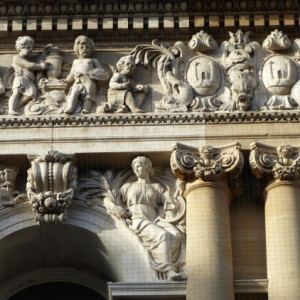"Pay on the Nail"
Four bronze tables are located outside The Corn Exchange on Corn Street, probably modelled after mobile tables which were taken to trade fairs and markets. Before the Corn Exchange was built in the 18th century, the tables—called nails—were located in the Tolzey Walk. This covered area was along the south wall of All Saints Church, which remains as a narrow lane giving access to commercial premises.
The bronze nails, with their flat tops and raised edges which prevent coins from tumbling onto the pavement, were made as convenient tables at which merchants could carry out their business. The oldest pillar is undated, but experts say it is late Elizabethan. The second oldest was given by Bristol merchant Robert Kitchin, who died in 1594. The two remaining nails are dated 1625 and 1631.
As the four nails were made at different times this is reflected in their varying designs. One of the nails bears the name John Barker on its rim. He was a wealthy merchant who owned houses and storehouses on the Quay, in Wine Street and Small Street. He was mayor during the reign of Charles 1 and represented Bristol in the 1623 Parliament.
Deals could be closed by payment on the nails—the popularly supposed origin of the saying "pay on the nail" or "cash on the nail".
The building on the left is the old Lloyds Bank - now up for grabs if you have deep pockets. The frontage is covered with carvings and friezes - see extra.


Comments
Sign in or get an account to comment.


